Tying Instructions:
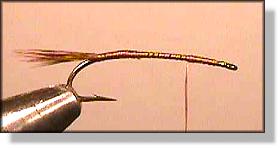
1. Start the thread above the hook point. Wrap back to a point
directly above the barb. Tie in tails at this point. Advance
the thread nearly to the eye, then wrap back to about two eye-widths
behind the eye. This will be the tie-in point for the wing.
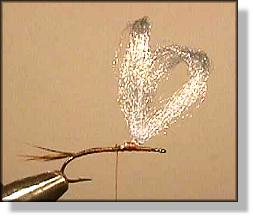
2. Tie in the wing material. I prefer to tie in a loop, rather than
free-ended fibers, as the loop makes it much easier to dub the
thorax and wrap the hackle without trapping wing fibers. Stand
the wing up. I prefer to use a single thread wrap as described
by Randall Kaufmann in Tying Dry Flies.
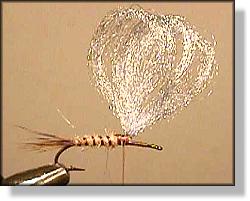
3. Tie in the ribbing, and bind it down while wrapping the thread
back to the tail. Apply dubbing to the thread (fairly thin and
tight) and dub a slender abdomen. Wrap the ribbing forward and
tie it off behind the wing.
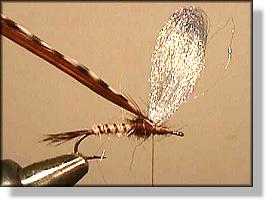
4. Dub the back half of the thorax (up to the wing). The thorax
should be much larger in diameter than the abdomen, and rather
"rough." Prepare a brown and a grizzly hackle by trimming the
"trash" from the base of the feather and stripping the barbs from
the first 1/4" of stem. Tie in both hackles with the dull side down,
and stems laying along the near side of the wing post.
(Note: This assumes wrapping the hackle clockwise. If your
personal preference is to wrap counter-clockwise, modify the
tie-in accordingly.)
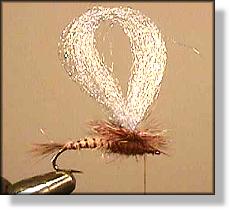
5. Dub the front half of the thorax. Wrap the hackles and tie
them off behind the eye. Trim the hackles, whip finish head,
trim the thread.

6. Trim the wing to shape. I prefer to gather all the fibers and
make one cut, from front to rear, on about a 45 degree angle from
horizontal. Place a drop of thinned head cement, or lacquer, on
the base of the wing where the wing meets the hackle. The cement
should disappear quickly, and when dry, will bomb-proof the wing
and hackle. "Rough-up" the thorax with a toothbrush or gun cleaning
brush. That's it!! ~ Arnie Wiese
Fishing Suggestions
The fish will usually tell you how to fish this fly. The hatch
generally comes off in the late afternoon, and fish will be rising
in runs and seam lines. The best presentation seems to be a dead
drift over rising fish. On sunny days, the adults will begin
laying eggs over runs and riffles by mid-morning. When the bright
sky would normally put the fish down, they will be found rising
almost recklessly under the swarms of egg-laying adults. When no
fish are rising, the fly is often successful if drifted through
likely feeding or resting lies. A stiff leader is required, as
the fly will twist light tippets. I generally use 4x, no longer
than 9 feet.
Other sizes and color combinations work well for other mayfly species.
A size 16, in pheasant tail nymph colors, produces well during PMD
hatches; and an olive or gray 18 often takes fish during Baetis
hatches.
|









